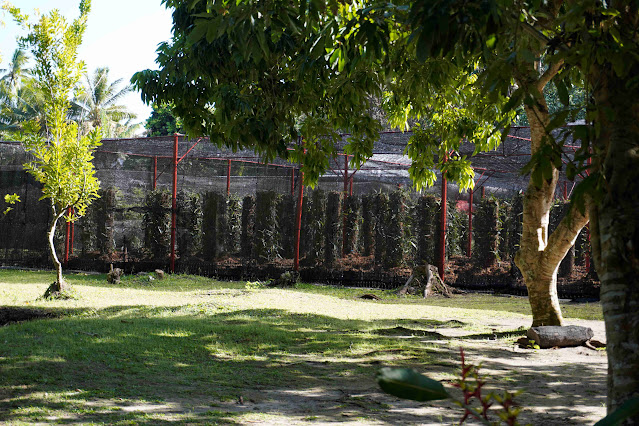- Get link
- X
- Other Apps
The entrance to the pass lies ahead of us. Pass is almost an exaggeration. It is a zigzag course. We are in front of Akamaru and want to enter the shallow water. The pass is blocked 100 meters after the entrance by a coral stick, which you have to go around to starboard, only to have another boomy in front of you right after that. The pass is narrow before you reach shallow water. 1.5 meters at high tide, one meter at low tide. On the large sandy area there are always small coral sticks, so-called boomies, which have to be avoided.
 |
| Anchorage Akamaru, Gambier Islands |
We drop the anchor at 1.5 meters. The wind drops in gusts up to 25 knots into the anchor field and with 15 knots west wind we jerk, again and again, into the bridle. Gaby is thrilled and would like to leave right away. Actually it is beautiful here. The colors shine and the anchor field is huge. At this time of the year we are alone. In the whole archipelago there are only two boats. The Swedish Hathor and our Katinka. With his two meter draft Christer would have no chance here. We with our 1.10 meters just make it. At low tide we still have one meter of water under the depth gauge. If you subtract the keel, this is the so-called hand width. Even with a dinghy you have to find your way ashore. A small shark swims curiously, in the crystal clear water, around our boat. Around us shining turquoise. A dream anchorage with southwest wind, even better with no wind at all.
 |
| Turquoise |
But why are we here despite these weather conditions? We were once again at the BBQ in Taravei and learned there that Maria is moving from Mangareva to Akamaru for eleven months. At the Assumption of Mary on August 15th. We don't want to miss that, and at the same time we want to have a look at the island. Even though there is a strong wind overnight, we find some sleep and are awakened early in the morning by the first boats, from Mangareva. Outside the pass the municipal pontoon boat is waiting, because the airport passenger ship, because of its draft, can not enter the lagoon. So Maria is reloaded and brought ashore with kettledrums and trumpets. Only in Polynesia it is not kettledrums and trumpets, but guitar and ukulele.
 |
| Gaby am Strand von Akamaru, Gambier Islands |
We also go ashore and moor the dinghy to a fallen tree trunk. I bring out a stern anchor, in the snow-white sand. Maria has arrived on the jetty in the meantime and is held on a stretcher by four "virgins" on her shoulders. A crowd of people have come over from Mangareva to witness the procession. The procession forms up and walks towards the church amidst music and singing.
 |
| Maria on Akamaru, Gambier Islands |
The church with its two towers is, of course, much too large for the island, although it cannot accommodate all the visitors today. Laval was the first to settle Akamaru with his missionaries. The church is therefore the oldest on the Gambiers.
 |
| Church on Akamaru, Gambier Islands |
Numerous stone houses stand dilapidated in the jungle. Nature is reclaiming everything. The houses that are used and of course the church itself, stand in a beautifully maintained garden. Since we naturally give priority to the locals, we cannot participate in the actual church service, the church is filled to capacity. We take the opportunity to look around a bit on the island. While the old stone houses, from the missionary time decay, the few Polynesians, who live here on the island, inhabit their here usual wooden houses. We walk through a banana grove towards a vanilla plantation. Here on two soccer field large surfaces, vanilla is cultivated. The air smells sweetly of the pods. A local proudly tells us that he owns everything here. We are happy for him.
 |
| Vanilla on Akamaru, Gambier Islands |
Once you have plotted the track on the plotter, it is easier to find it again. But you have to be careful where exactly the coral poles are. We use satellite images on OpenCPN and of course keep a lookout in front of the bow. Sailing is not possible, because the way back to Mangareva is full of pearl oyster buoys. The things are in the entire archipelago and are, with a swell of one meter, only quite late to recognize. So you have to constantly watch out and correct your course. Under sail this is very tedious. Therefore we sail back under engine and reach a wind-protected anchorage, where we spend a quiet, deep-sleeping night. This will be the last one for the next days, because the next low with up to 50 knots of wind is already at our doorstep. The next few days will bring cold air from the south again, so long pants and wool socks are the order of the day. If we are not frozen to next week, we report again and wish you solang, fair winds and keep a stiff upper lip.
- Get link
- X
- Other Apps

Comments
Post a Comment